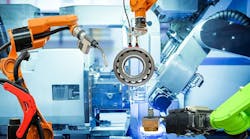Study: Welders Prefer Semi-Automated ARC Welding Equipment
The global sales of arc welding equipment reached ~1,600,000 (Units) in 2018, reveals the latest report on the arc welding equipment market. According to the study analysis, the global arc welding equipment market is projected to register ~6% CAGR during the forecast period of 2019 and 2029. Rising demand for arc welding products from several end-use industries such as automotive & transportation, energy, and construction are estimated to spur the growth of the arc welding equipment market in the forecast period.
According to the comprehensive research and deep study, an increasing number of housing and infrastructure projects and improving public transport facilities, inclusive of railways and roads, are expected to lead to significant growth in the arc welding market globally. Various arc welding technologies, such as Gas-Metal Arc Welding (GMAW) and Gas-Tungsten Arc Welding (GTAW), are widely used in the automobile industry. Growth of the market is expected to be further driven by evolving automobile designs in need of competitive arc welding procedures coupled with rising demand for automobiles.
Furthermore, several large-scale infrastructural projects launched as part of governments’ development programs are expected to emerge as major drivers for the growth of the arc welding equipment market in the international foothold. The global arc welding equipment market is estimated to reach the revenues worth ~US$ 5 Bn in 2019 and is expected to witness impressive growth towards the end of 2029.
Core Industrial Sectors Remain Prime Revenue Generation Channels
Increasing capital expenditure for construction activities coupled with mega infrastructure projects planned in the developing regions in the near future, are expected to drive the sales of arc welding equipment over the estimated period. Rampant investments in core industrial sectors are expected to drive the demand for arc welding equipment and gases throughout the forecast period.
Though shielded metal arc welding (SMAW) or more commonly known as stick welding technology is the oldest method of arc welding in the market today, it surprisingly holds the largest market share despite other arc welding technologies developed for different applications. Other welding technologies closely following the heels are flux-cored arc welding (FCAW), plasma arc welding (PAW), and gas metal arc welding (GMAW). Highly customized and specific welding operations call for gas tungsten arc welding (GTAW), which requires professional arc welding experienced personnel as it cannot be automated easily.
Welding operators find semi-automatic arc welding equipment to be more economic and efficient in comparison to manual and automatic arc welding equipment. Thus, increasing demand for semi-automatic arc welding is estimated to drive the global arc welding equipment market growth. Semi-automatic arc welding equipment, such as TIG (Tungsten Inert Gas), MIG (Metal Inert Gas), and flux-cored arc welding equipment are gaining traction in the Middle East & Africa market owing to growth in end-use industries, such as construction, energy, automotive, and oil & gas.
Emerging Market Trends Dictated by Technology & Gas Usage
Utilizing helium for the purpose of shielding in arc welding operations might have been fruitful, but its high price and scarcity have led to its uneven usage across various economies around the globe. The usage of helium is especially prevalent in countries where natural gas is abundant, which leads to a drastic reduction in selling prices. The U.S., Qatar, and Algeria are some of the major countries that produce around a combined 75% of the total global helium production. Helium, in such countries, is sold at around US$ 30,000 per ton, while the selling price in other countries can go up to as high as US$ 75,000 per ton. Recent inflation in helium prices has also been a worrying factor, as crude helium prices rose 135% year-on-year at a recently concluded U.S. government auction.
When it comes to selecting a shielding gas for metal welding operation through arc technology, inert gases top the list in comparison to other gases. Helium and argon are the two most common inert gases used in arc welding technology, but the high price of helium forces welding operators to choose argon for shielding purposes. Its low price coupled with advantageous shielding properties is likely to influence the dominance of argon in the arc welding equipment and gas market in the present scenario as well as in the future.
Arc Welding Equipment Market: Vendor Insights
The study analysis also highlights resourceful insights about the competitive structure of the arc welding equipment market and typical approaches of prominent market players. The global arc welding equipment market is estimated to be fairly fragmented with leading players accounting for less than 43% of the total market. Some of the key players identified in the global competitive market are Daihen Corporation, The Lincoln Electric Company, Colfax Corporation, Obara Group, Inc., Illinois Tool Works Inc, Hyundai Welding Co. Ltd, Fronius International GmbH, Panasonic Corporation, and Kemppi Oy.
This study highlights key opportunities in the arc welding equipment market and finds that the market would exhibit growth at a CAGR of ~6% during the forecast period.
These insights are based on a report on Arc Welding Equipment Market by Persistence Market Research.

